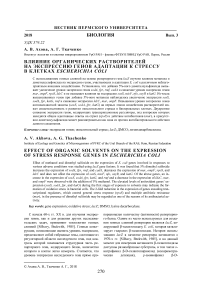Влияние органических растворителей на экспрессию генов адаптации к стрессу в клетках Escherichia coli
Автор: Ахова А.В., Ткаченко А.Г.
Журнал: Вестник Пермского университета. Серия: Биология @vestnik-psu-bio
Рубрика: Микробиология
Статья в выпуске: 3, 2018 года.
Бесплатный доступ
С использованием генных слияний на основе репортерного гена lacZ изучено влияние метанола и диметилсульфоксида на экспрессию генов, участвующих в адаптации E. coli к различным неблагоприятным внешним воздействиям. Установлено, что добавка 5%-ного диметилсульфоксида вызывает увеличение уровня экспрессии генов sodA, fpr, rmf, cadA и снижение уровня экспрессии генов mar, ompF, rpoS, ldcC и не оказывает влияния на экспрессию soxS, micF, nfo, oxyR и katG. Из числа вышеназванных генов при добавке 5%-ного метанола наблюдалось увеличение экспрессии soxS, sodA, fpr, katG, rmf и снижение экспрессии ldcC, mar, ompF. Повышение уровня экспрессии генов антиоксидантной защиты (soxS, sodA, fpr, katG) на первых этапах воздействия растворителей может свидетельствовать о развитии окислительного стресса в бактериальных клетках. Двукратное снижение экспрессии генов, кодирующих транскрипционные регуляторы, под контролем которых находятся общие адаптивные ответы на стресс (rpoS) и действие антибиотиков (mar), в присутствии диметилсульфоксида может рассматриваться как одна из причин антибактериального действия данного соединения.
Экспрессия генов, окислительный стресс, дмсо, лизиндекарбоксилаза
Короткий адрес: https://sciup.org/147227028
IDR: 147227028
Список литературы Влияние органических растворителей на экспрессию генов адаптации к стрессу в клетках Escherichia coli
- Шумков М.С. и др. Изменение экспрессии ldcC Escherichia coli как фактор адаптации к антибиотикам // Вестник Пермского университета. Сер. Биология. 2010. Вып. 1. С. 36-40.
- Biran A. et al. Bacterial genotoxicity bioreporters // Microbial Biotechnology. 2010. Vol. 3, № 4. P. 412-427.
- Biran I. et al. Optical imaging fiber-based live bacterial cell array biosensor // Analytical Biochemistry. 2003. Vol. 315, № 1. P. 106-113.
- Gonzalez-Flecha B.,Demple B. Transcriptional regulation of the Escherichia coli oxyR gene as a function of cell growth // Journal of bacteriology. 1997. Vol. 179, № 19. P. 6181-6.
- Hidalgo E., Leautaud V., Demple B. The redox-regulated SoxR protein acts from a single DNA site as a repressor and an allosteric activator // EMBO Journal. 1998. Vol. 17, № 9. P. 2629-2636.
- Kikuchi Y. et al. RpoS-dependent expression of the second lysine decarboxylase gene in Escherichia coli // Bioscience, Biotechnology, and Biochemistry. 1997. Vol. 62, № 6. P. 1267-1270.
- Kim I., Oh T. SOS induction of recA by UV-, y-irradiation and mitomicin C is mediated by poly-amines in Escherichia coli K-12 // Toxicology Letters. 2000. Vol. 116. P. 143-149.
- Lange R., Hengge-Aronis R. The cellular concentration of the sigma S subunit of RNA polymerase in Escherichia coli is controlled at the levels of transcription, translation, and protein stability // Genes & Development. 1994. Vol. 8, № 13. P. 1600-1612.
- Lehmann M. et al. Amperometric measurement of copper ions with a deputy substrate using a novel Saccharomyces cerevisiae sensor // Biosensor and Bioelectronics. 2000. Vol. 15, № 3-4. P. 211-219.
- Martin R., Gillette W., Rosner J. Promoter discrimination by the related transcriptional activators MarA and SoxS: differential regulation by differential binding // Molecular Microbiology. 2000. Vol. 35, № 3. P. 623-634.
- Miller J.H. Experiments in molecular genetics. N.Y.: Cold Spring Harbor Laboratory, 1992. 466 p.
- Ng S., Palombo E., Bhave M. Identification of a copper-responsive promoter and development of a copper biosensor in the soil bacterium Achromobacter sp. AO22 // World Journal of Microbiology and Biotechnology. 2012. Vol. 28, № 5. P. 2221-8.
- Park S., Chung H., Lee J. Rapid in vivo screening system for anti-oxidant activity using bacterial re-dox sensor strains // Journal of Applied Microbiology. 2010. Vol. 108, № 4. P. 1217-1225.
- Quillardet P. et al. SOS chromotest, a direct assay of induction of an SOS function in Escherichia coli K-12 to measure genotoxicity // Proceedings of the National Academy of Sciences USA. 1982. Vol. 79, № 19. P. 5971-5975.
- Samartzidou H. et al. Cadaverine inhibition of porin plays a role in cell survival at acidic pH // Journal of bacteriology. 2003. Vol. 185, № 1. P. 13-19.
- Seyedsayamdost M. High-throughput platform for the discovery of elicitors of silent bacterial gene clusters // Proceedings of the National Academy of Sciences USA. 2014. Vol. 111, № 20. P. 7266-7271.
- Silhavy T., Beckwith J. Uses of lac fusions for the study of biological problems // Microbiological Reviews. 1985. Vol. 49, № 4. P. 398-418.
- Stocker J. et al. Development of a set of simple bacterial biosensors for quantitative and rapid measurements of arsenite and arsenate in potable water // Environmental Science & Technology. 2003. Vol. 37, № 20. P. 4743-4750.
- van Rensburg J. et al. Development and validation of a high-throughput cell-based screen to identify activators of a bacterial two-component signal trans-duction system // Antimicrobial Agents and Chemotherapy. 2015. Vol. 59, № 7. P. 3789-3799.
- Yagi K. Applications of whole-cell bacterial sensors in biotechnology and environmental science // Applied Microbiology and Biotechnology. 2007. Vol. 73. P. 1251-1258.
- Yamagishi M. et al. Regulation of the Escherichia coli rmf gene encoding the ribosome modulation factor: growth phase- and growth rate-dependent control // EMBO Journal. 1993. Vol. 12, № 2. P. 625-630.


